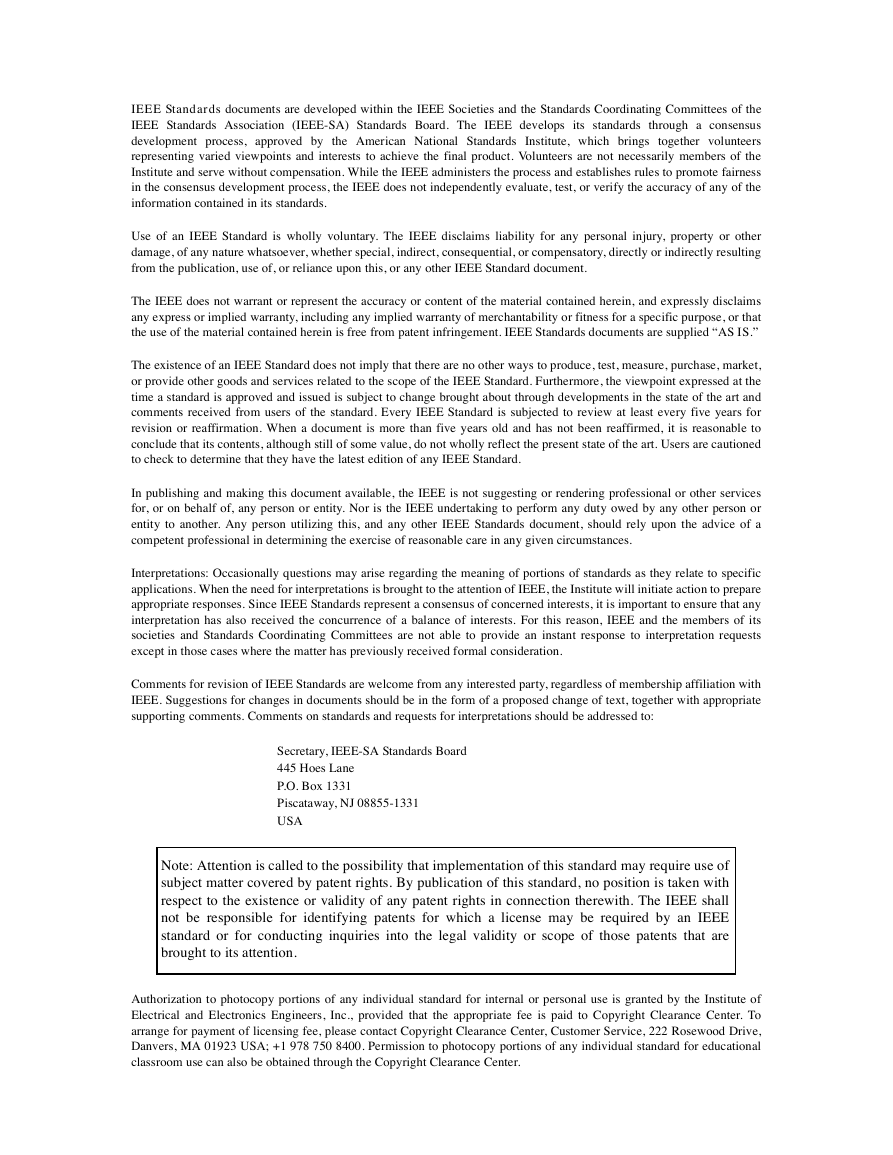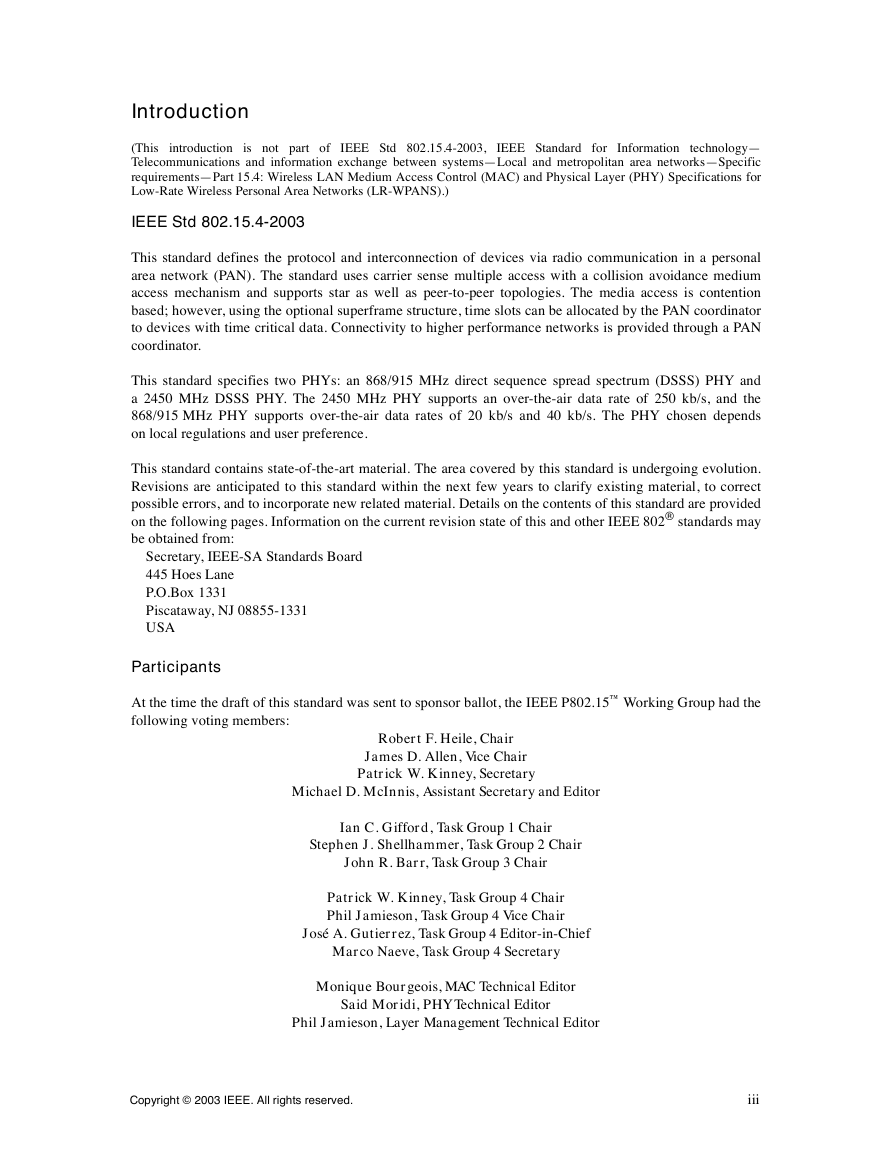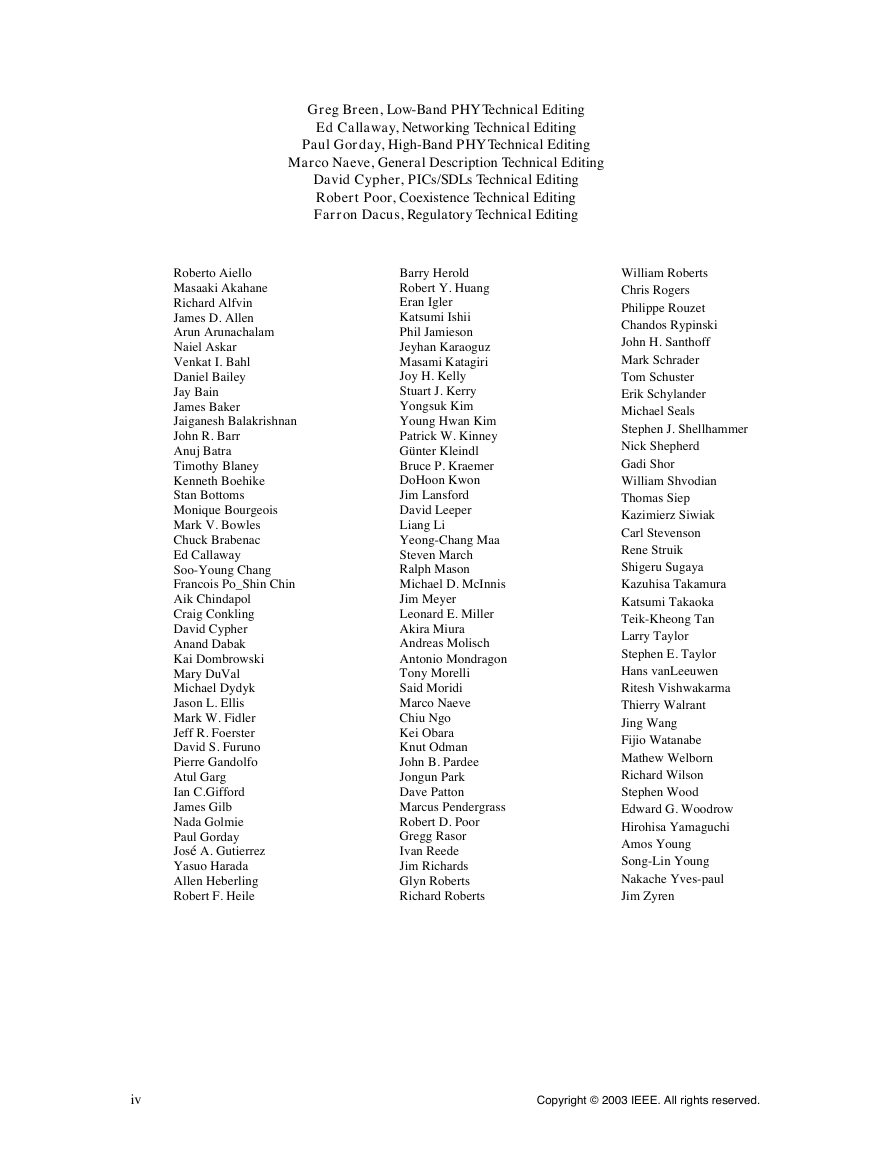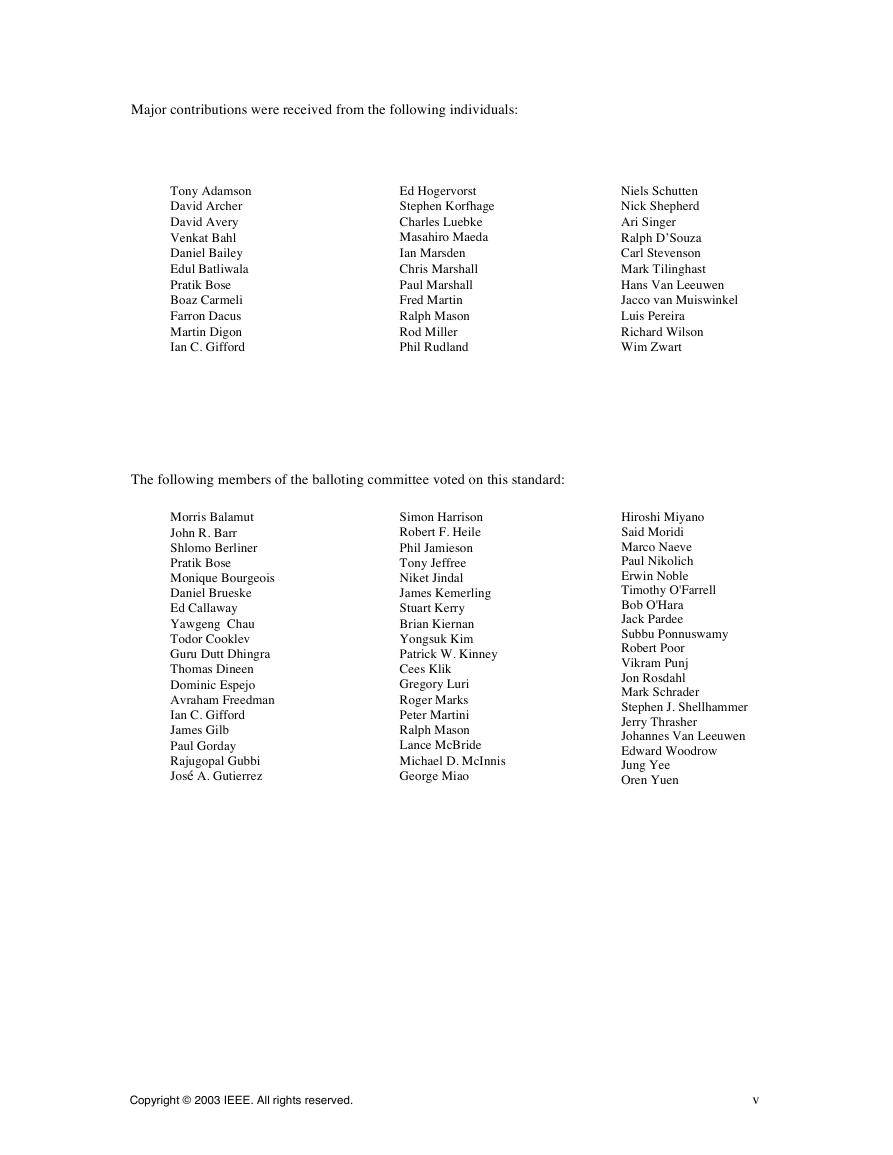Title Page
Introduction
Participants
CONTENTS
1. Overview
1.1 Scope
1.2 Purpose
2. References
2.1 IEEE documents
2.2 ISO documents
2.3 ITU-T documents
2.4 Other documents
3. Definitions
4. Acronyms and abbreviations
5. General description
5.1 Components of the IEEE 802.15.4 WPAN
5.2 Network topologies
5.3 Architecture
5.4 Functional overview
5.5 Concept of primitives
6. PHY specification
6.1 General requirements and definitions
6.2 PHY service specifications
6.3 PPDU format
6.4 PHY constants and PIB attributes
6.5 2450 MHz PHY specifications
6.6 868/915 MHz band PHY specifications
6.7 General radio specifications
7. MAC sublayer specification
7.1 MAC sublayer service specification
7.2 MAC frame formats
7.3 MAC command frames
7.4 MAC constants and PIB attributes
7.5 MAC functional description
7.6 Security suite specifications
7.7 Message sequence charts illustrating MAC-PHY interaction
Annex A
A.1 802.2 Convergence sublayer
A.1.1 MA-UNITDATA.request
A.1.2 MA-UNITDATA.indication
A.1.3 MA-UNITDATA-STATUS.indication
Annex B
B.1 Generic CCM mode
B.1.1 Inputs
B.1.2 Authentication
B.1.3 Encryption
B.1.4 Output
B.1.5 Decryption
B.1.6 Restrictions
B.1.7 List of symbols
B.2 CTR Encryption
B.3 CBC-MAC
Annex C
C.1 Introduction
C.1.1 Scope
C.1.2 Purpose
C.2 Abbreviations and special symbols
C.3 Instructions for completing the PICS proforma
C.4 Identification of the implementation
C.5 Identification of the protocol
C.6 Global statement of conformance
C.7 PICS proforma tables
C.7.1 Major roles for IEEE 802.15.4 devices
C.7.2 Major capabilities for the PHY
C.7.3 Major capabilities for the MAC sublayer
Annex D
D.1 Specification and description language (SDL)
D.1.1 SDL overview
D.1.2 SDL system overview
D.1.3 IEEE 802.15.4 SDL model overview
D.2 IEEE 802.15.4 PHY package
D.2.1 Block type Phy_block
D.3 IEEE 802.15.4 MAC sublayer package
D.3.1 Block type MAC_block
D.4 Signal definition package
D.4.1 Signal definition package (1)
D.4.2 Signal definition package (2)
D.4.3 Signal definition package (3)
D.4.4 Signal definition package (4)
D.4.5 Signal definition package (5)
D.4.6 Signal definition package (6)
D.4.7 Signal definition package (7)
D.4.8 Signal definition package (8)
D.4.9 Signal definition package (9)
D.4.10 Signal definition package (10)
D.4.11 Signal definition package (11)
D.4.12 Signal definition package (12)
D.4.13 Signal definition package (13)
D.4.14 Signal definition package (14)
D.4.15 Signal definition package (15)
D.4.16 Signal definition package (16)
D.4.17 Signal definition package (17)
D.4.18 Signal definition package (18)
D.4.19 Signal definition package (19)
D.4.20 Signal definition package (20)
Annex E
E.1 Standards and proposed standards characterized for coexistence
E.2 General coexistence issues
E.2.1 CCA
E.2.2 Modulation
E.2.3 ED and LQI
E.2.4 Low duty cycle
E.2.5 Low transmit power
E.2.6 Channel alignment
E.2.7 Neighbor piconet capability
E.3 Coexistence performance
E.3.1 Assumptions for coexistence quantification
E.3.2 BER model
E.3.3 Coexistence simulation results
E.4 Notes on the calculations
Annex F
F.1 Introduction
F.2 Applicable U.S. (FCC) rules
F.2.1 Section 15.35 of FCC CFR47
F.2.2 Section 15.209 of FCC CFR47
F.2.3 Section 15.205 of FCC CFR47
F.2.4 Section 15.247 of FCC CFR47
F.2.5 Section 15.249 of FCC CFR47
F.3 Applicable European rules
F.3.1 European 2400 MHz band rules
F.3.2 European 868-870 MHz band rules
F.4 Known Japanese rules
F.5 Emissions specification analysis with respect to known worldwide regulations
F.5.1 General analysis and impact of detector bandwidth and averaging rules
F.5.2 Frequency spreading and averaging effects specific to IEEE 802.15.4
F.6 Summary of out-of-band spurious emissions limits
F.7 Phase noise requirements inferred from regulatory limits
F.8 Summary of transmission power levels
Annex G
G.1 General
G.2 Regulatory documents
















 uCOS-III的任务调度算法研究.pdf
uCOS-III的任务调度算法研究.pdf STM32F103x8B_DS_CH_V10(7STM32中文数据手册).pdf
STM32F103x8B_DS_CH_V10(7STM32中文数据手册).pdf FX2N系列PLC培训教程.pdf
FX2N系列PLC培训教程.pdf Modbus协议资料.pdf
Modbus协议资料.pdf WM8978中文资料(芯片资料).doc
WM8978中文资料(芯片资料).doc 5-1.【Codelab】HarmonyOS基于图像模块实现图库图片的四种常见操作.pdf
5-1.【Codelab】HarmonyOS基于图像模块实现图库图片的四种常见操作.pdf GX Developer 编程软件使用说明.pdf
GX Developer 编程软件使用说明.pdf MR-E伺服与FX3G接线图.pdf
MR-E伺服与FX3G接线图.pdf ATK-NEO-6M GPS模块常见问题汇总_201400721.pdf
ATK-NEO-6M GPS模块常见问题汇总_201400721.pdf STM32F407ZGT6(芯片资料).pdf
STM32F407ZGT6(芯片资料).pdf FM1715编程指南.pdf
FM1715编程指南.pdf Profibus教程-7.PROFIBUS-FMS.pdf
Profibus教程-7.PROFIBUS-FMS.pdf